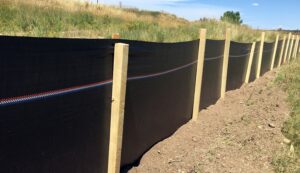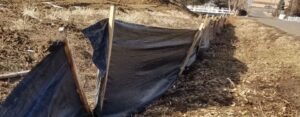In January, St. Johns RIVERKEEPER was alerted by several concerned citizens about a muddy plume or sedimentation runoff adjacent to the Southbank Riverwalk in Downtown Jacksonville.

Photo taken at the Southbank. The Peninsula of Jacksonville Building, 1431 Riverplace Blvd, Jacksonville, FL 32207
The photo, a screenshot from a video, provided St. Johns Riverkeeper a birds eye view to visually understand the full magnitude of the sedimentation runoff. The video was also helpful in that it displayed the direction in which the plume was moving:

The blue pin in the map above indicates the building from where the video was sent and the blue arrow shows the direction the sediment was moving.
After receiving the video, St. Johns Riverkeeper immediately contacted the City of Jacksonville Environmental Quality Division (EQD) and the Florida Department of Environmental Protection (FDEP). Potential sources have been identified by both EQD, FDEP, and the St. Johns River Water Management District (SJRWMD). While the complaint and video were both received on January 24, Riverkeeper staff is maintaining communication with the agencies to identify the source of the contamination and to ensure appropriate measures are being taken to prevent additional muddy runoff.
Water polluted with sediment can prevent natural submerged aquatic vegetation from growing, threatening the food source of commercially and recreationally important wildlife. Sediment polluted water can also become a contributing factor in fish deaths. Runoff can pick up fertilizer, oil, pesticides, dirt, bacteria, and other pollutants that are harmful to the river and the organisms which call it home. There are also economic consequences associated with sediment runoff. Waterways clogged with sediment can reduce property values and property taxes by limiting access for boating. In addition, dredging and restoration projects to fix sedimentation problems can cost millions of dollars to complete.
Construction site runoff is a significant threat to the ecological health of the St. Johns River and its tributaries. When contractors don’t install or properly maintain required erosion controls, or BMPs (Best Management Practices), muddy water can run off into our waterways during rainfall events. Have you ever seen those black screens or fences that surround a construction site? This is an example of a BMP installed to prevent dirt from leaving the site:

✓ Properly Maintained Silt Fence

✖ Not Properly Maintained Silt Fence
In some instances, standing water on a construction site is intentionally pumped into nearby gutters, storm drains, and creeks. In either case, these are illegal stormwater violations that can and should result in enforcement actions by our regulatory agencies.
Ongoing construction and development projects, while important in sustaining a growing Jacksonville, have the potential to result in similar events. So, keep your eyes open for muddy water flowing into nearby storm drains or waterways and construction sites without proper erosion control BMPs installed. If you see a potential violation, contact St. Johns RIVERKEEPER and report to the appropriate environmental agencies. Click here for a list of agency contacts. As evidenced by the Southbank Sedimentation event, concerned and engaged citizens can make a difference for our St. Johns River and its tributaries!
